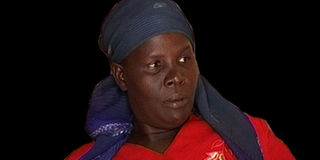Alice Lakwena: The warrior priestess

Alice Lakwena
What you need to know:
For every journey, there are victories and fond memories to celebrate, as there are terrors that cannot be forgotten. The influence of the woman that gave beginnings to the terror that has been the ruthless rebel leader, Joseph Kony, in Northern Uganda is one such memory we cannot ignore as we think back on Uganda’s past 50 years, writes Brian Magoba.
Illiterate, a fish-and-flour vendor, or prostitute depending on who you asked, and a female. Ordinarily, any one of these factors would have disqualified Alice Auma from being a leader of men. But, she claimed that God spoke through her, and they followed her into a war waged supposedly to purify Uganda and restore Acholi glory.
On May 25, 1985, she reportedly lost hearing and speaking ability. Several failed traditional interventions later, she disappeared into Paraa National Park and emerged 40 days later as the spirit-medium of a dead Italian soldier whose name, Lakwena, means “messenger” in the Acholi language.
On August 6, 1986, Lakwena allegedly ordered Auma to form a Holy Spirit Movement (HSM) that would fight evil and end bloodshed. But the HSM’s songs, sticks, stones and “magic” shea-butter oil were no match for the National Resistance Army’s bullets and organisational superiority.
Alice escaped with her life to Kenya, where she died in relative oblivion on January17, 2007 at Ifo Refugee Camp near Dadaab in Northern Kenya. The stragglers who re-assembled under the command of her alleged cousin Joseph Kony formed a force that instead engineered the longest and bloodiest rebellion in Uganda’s post-Independence history.
Raising Kony
After the HSM’s defeat in November 1987, Kony regrouped the force under a new name, the United Holy Salvation Army, which he rebranded to the Uganda Christian Army, before settling for the Lord’s Resistance Army (LRA) in 1992.
Xeroxing Alice’s application of spiritualism to war , he used a warrior-messiah persona to graduate what started out a macabre version of Acholi nationalism into an insurgency that drew international attention.
In name and doctrine, both outfits declared Christian leanings—Alice’s father a priest, Kony a former altar-boy. Kony also claimed that African spirits with European names (Major Bianca, King Bruce and Silver in his case) influenced his practices and beliefs.
But where Lakwena’s social banditry was like a badly skewed Robinhood episode, Kony’s went from avenger to unrepentant abductor of innocents, to an internationally-wanted lord of war. He became the face of “the war in Northern Uganda”, as local and international media dubbed it. Soon it transformed into a geo-political conflict involving South Sudan, the Democratic Republic of Congo (DRC), and the Central African Republic (CAR).
With no Alice Lakwena to start him off, Kony may never have joined the International Police’s list of ‘Most Wanted” criminals and unanimously won himself the tag of Uganda’s most hated person.
Twisted Faith-mongering
Alice Lakwena’s version of Jesus’ desert retreat involved her consulting the animals and natural elements in Paraa National Park, under Lakwena’s guidance in 1985. For 40 days she learned the various means necessary for the redemption of the Acholi and aiding the establishment of an earthly paradise. Spiritual purity being their only insurance against bullets, the faith of Lakwena’s followers equalled for ludicrousness that of the Maji Maji resistance fighters before her.
President Idi Amin overnight changed Uganda’s economic landscape with his expulsion of Asian-Ugandans in fulfilment of a dream that allegedly planted the idea in his mind. Joseph Kibwetere killed 1000 followers in Kanungu in March 2000 with his apocalyptic message at the Movement for the Restoration of the Ten Commandments of God.
Currently we debate the potential large-scale effects of Ryuho Okawa’s cult-like Happy Science Movement (HSM). In future anytime we suspect faith-based movements of advocating willful blood-spilling for ulterior motives, Alice Lakwena’s HSM will be a shining example.
Legacy
Like her beginnings, the tail-end of her life was newsworthy for all the wrong reasons. In November 2004 she was implicated in trafficking children from Gulu to the Ifo refugee camp in Kenya’s Garissa district. In 2006 she claimed to have found a cure for the HIV/AIDS she is alleged to have died from.
Although she mothered the longest-running magic-based war in Africa, she pleaded with Kony to give up fighting so that the Acholi would live in peace. Any good Lakwena ever achieved was interred with her bones. But the negative effects of her syncretism of religious beliefs will be remembered by Uganda and the world as the raw material for a horror show that has negatively defined Uganda’s image almost as much as the reign of the late Idi Amin Dada.
Fact file
• Lakwena the spirit allegedly resumed its work in her father, Severino Lukoya, after Alice fled to Kenya. The father also played a minor role in the UPDA’s initial stages, but not enough for him to be centre-stage like she was. He is the one who took her on “traditional consultations” before she went to the Paraa Park where she emerged with his wild tale.
• HMS’ rebellion lasted August 1985 to November 1986.
• Alice’s Holy Spirit Safety Precautions included, among others, “all men having neither less nor more than two testicles”.
• She allegedly fled to Kenya on a bicycle. Ironically, Kony’s eleventh commandment became “thou shalt not ride a bicycle.”
• Lakwena the Italian spirit allegedly drowned in the river Nile in the first World War, and reputedly spoke 74 languages.
• Other spirits that inhabited Alice included America’s Wrong Element, Zaire’s Franko, and Nyaker, an Acholi nurse.




